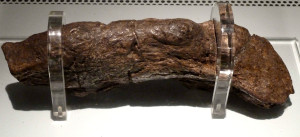Norrköping Air part of the team that is starting up a new project called “PalaeoFaeces.” In order to develop the project, members of the working group meet in StockholmJanuary 23-27. Here is an introductory text to the project:
Throughout our evolutionary history, the human microbiome has gone through some significant changes. Examinations of paleofeaces (human excrement that is thousands of years old) suggest that there has been a major extinction event in the human gut. The ancient microbiome contained 40% of species that were previously unknown to science. Furthermore, the ancient microbiomes had a higher number of transposases which contain elements of DNA sequences that can change location in the genome. So, the microbes might use this much larger collection of transposases to grab and collect genes that could help them adapt to different environments. One species, Treponema succinifaciens, was found in all of the ancient microbiomes but is completely absent in the modern western microbiome. In the words of researcher Aleksandar Kostic, “These are things we don’t get back.”
These changes to our microbiome go hand in hand with technological inventions and there are four major changes that altered our human microbiota significantly. The first of these was the discovery and use of fire. Although it is hard to pinpoint exactly when this occurred and became widespread practice, it is usually estimated to had happened around 2 million to 400 000 years ago. The second big change was the process of developing agriculture, which happened over 5000 years and that was fully in place approximately 10,000 years ago. Pre-agricultural societies had a much higher microbial diversity. The reason for this is most likely the more diverse diet of hunter-gatherer societies. Compared to agricultural societies, the hunter-gatherers traveled over a wider area. But even the traditional societies that rely on agriculture have a higher microbial diversity than their modern western counterparts.
But the most significant change occurred over the last 300 years or so, with the start of industrialisation. This process was intensified after the 1950 with what has been called The Great Acceleration. During this time the invention and use of antimicrobial agents, such as biocides, disinfectants and antibiotics has increased, exponentially killing off, not only the “bad” microbes but also the ones who are beneficial for human health. The increased use of pharmaceutical products has also had a negative impact on the microbes in the gut. There is a paradox in all of this. For while we, in western society, have the opportunity to have a diet that is much more diverse than the hunter-gatherer could only dream of, and thus have an even higher microbial diversity, we simply don’t. Why is that? One of the main differences between ancestral human microbiome and those of humans in the developed world is that the ancient population were exposed to the microbiota from a relatively small geographical area something that would change during the age of exploration.
So, what is a historical microbiome? What can we learn from what we have lost? Is there a historicity to the microbiome?


No comments:
Post a Comment